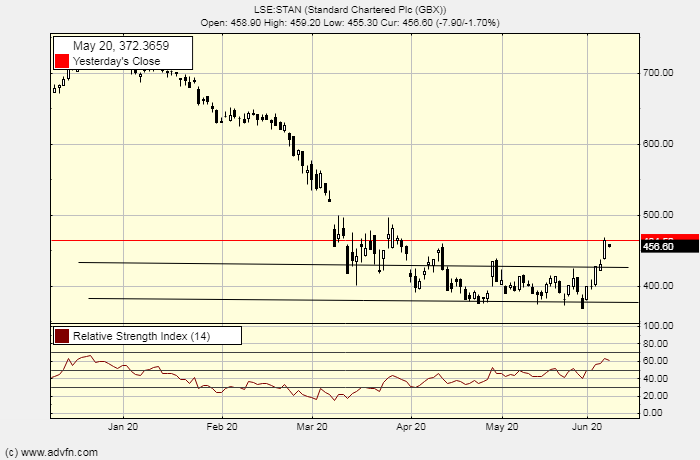Standard Chartered breaks important supply zones as buyers emerge
By
Azeez Mustapha
PUBLISHED:
Jun 08 2020 @ 03:53
|
Comments (0)
|
More info about Azeez Mustapha
Standard Chartered shares (LSE:STAN) have broken the previous supply zones at 460.00, 450.00 and 440.00 to the upside, and those supply zones are now demand zones.
The market ranged between March and May 2020, having trended downwards prior to that. Price then broke upwards, trending above the upper Trendline and closing above it. The RSI period 14 is already above the level 60, going into the overbought territory.

Yes, the market looks overbought in the short-term, and that may lead to a transitory pullback, which the uptrend will be resumed and more and more supply zones will be broken as price aims for 480.00, 490.00 and 500.00. Price will eventually go above these levels.
The outlook for STAN is bullish for this year.
Trading realities: Trading realities
CLICK HERE TO REGISTER FOR FREE ON ADVFN, the world's leading stocks and shares information website, provides the private investor with all the latest high-tech trading tools and includes live price data streaming, stock quotes and the option to access 'Level 2' data on all of the world's key exchanges (LSE, NYSE, NASDAQ, Euronext etc).
This area of the ADVFN.com site is for independent financial commentary. These blogs are provided by independent authors via a common carrier platform and do not represent the opinions of ADVFN Ltd. ADVFN Ltd does not monitor, approve, endorse or exert editorial control over these articles and does not therefore accept responsibility for or make any warranties in connection with or recommend that you or any third party rely on such information. The information available at ADVFN.com is for your general information and use and is not intended to address your particular requirements. In particular, the information does not constitute any form of advice or recommendation by ADVFN.COM and is not intended to be relied upon by users in making (or refraining from making) any investment decisions. Authors may or may not have positions in stocks that they are discussing but it should be considered very likely that their opinions are aligned with their trading and that they hold positions in companies, forex, commodities and other instruments they discuss.

 Hot Features
Hot Features













